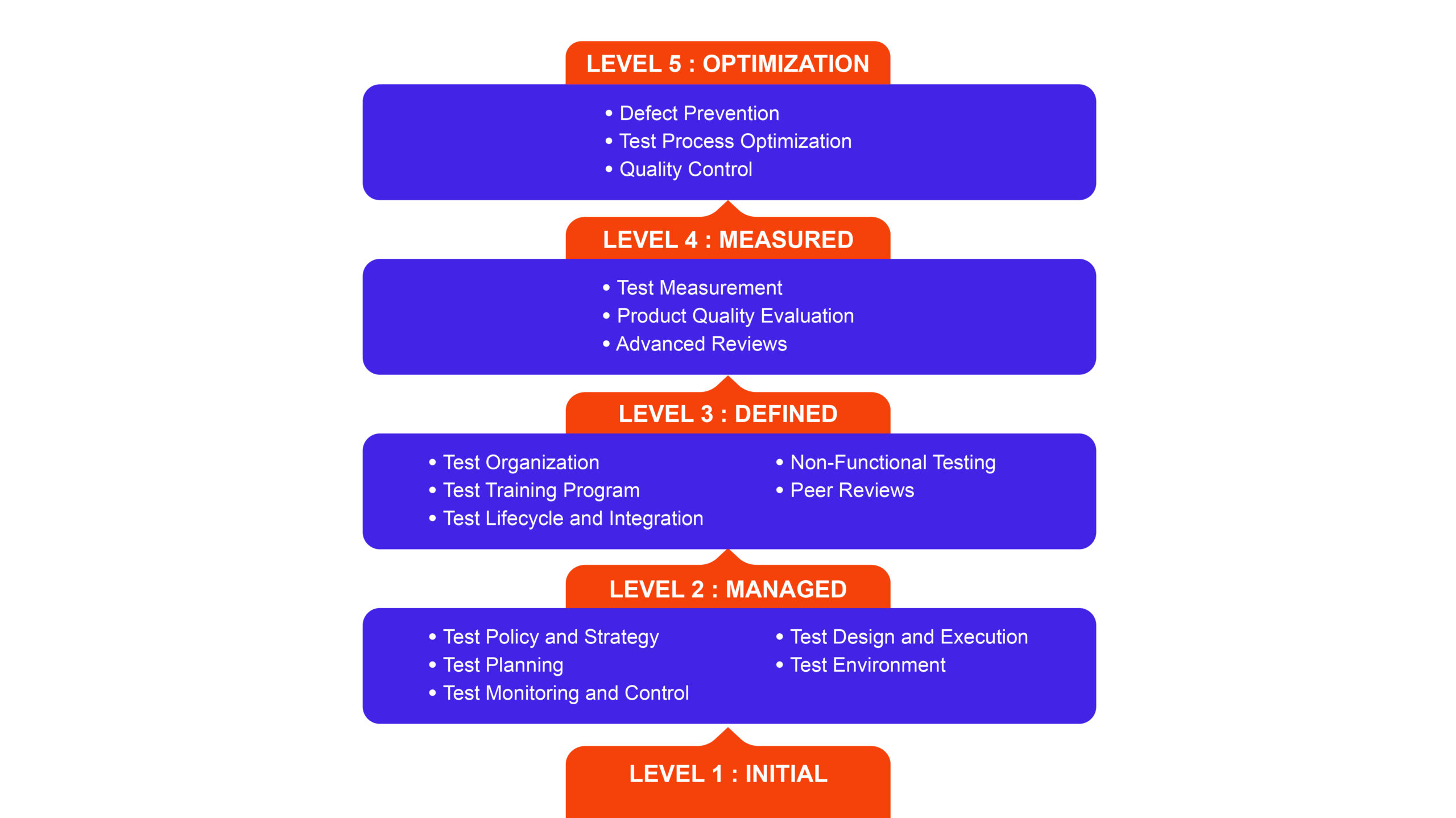
Implementing TMMi (Test Maturity Model integration) involves implementing various controls across different areas of the testing process to ensure consistency, reliability, and improvement in testing practices. Here are some key controls that should be considered for each maturity level of TMMi:
Level 1: Initial
– Basic Test Process Definition: Establish a basic process for testing activities, including test planning, execution, and reporting.
– Ad Hoc Test Execution: Define guidelines for ad hoc testing activities to ensure some level of structured testing.
– Defect Reporting: Implement a basic defect reporting process to capture and track issues identified during testing.
– Configuration Management: Establish basic controls for configuration management of testware and test environments.
– Duration: 3 to 6 months
– Activities: This phase involves conducting an initial assessment, establishing basic testing processes, and setting up rudimentary controls for testing activities. The focus is on laying a foundation for more structured testing practices.
Level 2: Managed
– Test Policy and Strategy: Define and communicate a formal test policy and strategy aligned with business objectives.
– Test Planning: Develop comprehensive test plans that outline test objectives, scope, resources, and schedule.
– Test Monitoring and Control: Implement mechanisms to monitor test progress, track deviations, and take corrective actions as needed.
– Test Environment Management : Establish controls for managing test environments, including configuration, availability, and access.
– Duration: 6 to 12 months
– Activities: Implementing management controls such as formal test policies, comprehensive test planning, and establishing mechanisms for monitoring and controlling testing activities. This phase requires embedding these practices across projects and teams.
Level 3: Defined
– Test Process Optimization: Continuously improve testing processes based on quantitative data and feedback.
– Metrics and Measurement: Define and use metrics to measure testing effectiveness, efficiency, and coverage.
– Formal Reviews and Audits: Conduct formal reviews and audits of testing processes and deliverables to ensure compliance and effectiveness.
– Training and Competence Development: Provide training programs and career paths to enhance testers’ skills and competencies.
– Duration: 12 to 18 months
– Activities: Standardizing and optimizing testing processes across the organization. This includes process optimization based on quantitative data, defining and implementing metrics for measurement, and enhancing training and competence development programs.
Level 4: Quantitatively Managed
– Quantitative Process Management: Establish statistical methods to manage and control the testing process quantitatively.
– Predictive Models: Develop predictive models based on historical data to forecast and manage testing efforts.
– Quality Assurance: Implement independent quality assurance activities to validate adherence to testing standards and processes.
– Continuous Improvement: Foster a culture of continuous improvement through regular feedback loops and proactive improvement initiatives.
– Duration: 18 to 24 months
– Activities: Implementing quantitative process management using statistical methods, predictive models, and advanced quality assurance practices. This phase focuses on achieving consistency and predictability in testing outcomes through data-driven decision-making.
Level 5: Optimizing
– Innovation and Technology Adoption: Encourage innovation in testing practices and leverage emerging technologies (e.g., AI/ML, automation).
– Risk-Based Testing: Implement risk-based testing strategies to prioritize testing efforts based on business and technical risks.
– Benchmarking: Compare testing practices against industry benchmarks and best practices for further optimization.
– Organizational Learning: Establish mechanisms for capturing and sharing lessons learned and best practices across the organization.
– Duration: Ongoing
– Activities: Continuously innovating and optimizing testing practices to achieve the highest level of maturity. This involves adopting emerging technologies, implementing risk-based testing strategies, and fostering a culture of continuous improvement and organizational learning.
Additional Controls Across Levels:
– Change Management: Implement controls for managing changes to testware, requirements, and test environments.
– Documentation Management:Establish processes for documenting test plans, test cases, and test results comprehensively.
– Vendor Management: Define controls for managing testing activities performed by external vendors or contractors.
– Compliance and Standards: Ensure adherence to relevant standards, regulations, and compliance requirements in testing activities.
Considerations for Implementing Controls:
– Tailoring: Customize controls based on the organization’s size, complexity, industry, and specific business needs.
– Integration: Ensure integration of testing controls with overall project management and software development processes.
– Automation: Leverage automation tools and techniques to streamline testing activities and improve efficiency.
– Measurement and Reporting: Establish mechanisms for reporting on control effectiveness and testing performance to stakeholders.
Factors Influencing Journey Time:
1. Organizational Readiness: The readiness of the organization to embrace change and allocate resources (time, budget, personnel) towards TMMi implementation.
2. Complexity of Projects: Larger and more complex projects may require longer implementation times to ensure comprehensive coverage of testing processes.
3. Size of the Organization: Larger organizations with multiple teams and projects may require phased implementations across different departments or business units.
4. Leadership Support: Strong support from senior management is crucial for driving and sustaining TMMi implementation efforts.
5. Training and Development: Time invested in training and upskilling personnel in new processes, tools, and methodologies.


